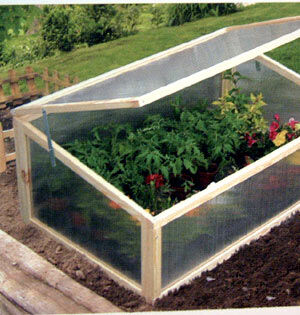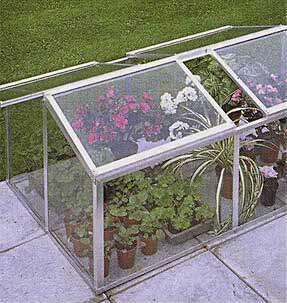Every spring gardeners everywhere compete to see who can get the earliest tomatoes, or the first corn of the season. Wall of Water and similar products are sold specifically for this reason. Another option for frugal gardeners is the cold frame.
A cold frame is basically a box that you plant in on the ground with a cover that allows light in, but keeps the cold at bay. Usually this takes the shape of an old window, but you don’t have to be limited to that.
First, figure out what you are going to use as the top of your cold frame. If this is a window, you need to make the planting box the same size as the window. In most cases you’ll want to use 2×4, 2×6 or 2x8s for the box, but if you look around, you might find other things around the house that you can use. On a budget? No problem! There are lots of great places to scrounge free or low-cost lumber and windows.Can’t get windows? I’ve heard of people using translucent shower curtains, doubled up dry cleaning bags, heavy clear plastic (Which you can sometimes buy at the foot at some hardware stores), clear, heavy garbage bags, or anything else that lets in plenty of light.
Freecycle is a favorite organization for frugal gardeners everywhere to find thing other people are trying to get rid of. Craig’s list is also a great resource. In Utah we have the KSL.com classifieds section, which has lots of areas to look from building materials to free stuff people are just trying to give away.
A lot of home stores like Home Depot or Menards sell cull lumber at a big discount–this is lumber from packaging, runners from the bottom of pallets, pieces they cut off of full-length boards that arrived damaged, etc. You can get some really great deals if you’re willing to check back often.
Another option is the wavy clear PVC stuff you find in home stores by the metal roofing. It is durable, inexpensive, and easy to work with.
And I personally love Habitat For Humanity’s Re-Store. Donated goods that are in good condition can be bought at great deals here. You can pick up cabinets, windows, doors, paint, scrap lumber, hardware, and more for a fraction of the usual price–even new stuff sometimes. Not sure where one is, do an Internet search for Habitat for Humanity in your area. Most medium-large cities have one.
So now you’ve scrounged your materials, the frame itself is easy to put together. Simply connect four boards in a rectangle so they’re the same size as the window you’re going to use on top. Hinge the window so it can be easily opened. Most of the time a hinged 2×2 is added to the bottom to allow the user to prop the top up. You probably want to let it sit closed for a few days before using it to allow the soil temperature to come up a few degrees, then go ahead and plant in the frame. On many bright, sunny days you’ll have to prop the window open a little to allow excess heat to escape, otherwise you’ll cook your plants.
Ideally you’ll build the cold frame so it faces south, and with a ten-degree angle on the top to increase heat in the frame, but if your building skills don’t stretch to figuring angles like that, even a flat cold frame in a good, sunny location will be beneficial. Also, if the bottom of the frame is buried even a little under the ground, you’ll get better heat retention.
Alternately, if you can’t find a window, but have access to lots of clear plastic, you could stretch the plastic over the top, then weight it down on the corners with rocks or other heavy objects. The end results are the same.
In most areas, using a cold frame or similar system will allow you to grow your own vegetables for months longer every year, starting in the early spring, and stretching into late fall. In milder temperature areas where it only dips a few degrees below freezing in winter, you might even be able to garden year-round this way.
If you really don’t have the time or talents to build a cold frame yourself, there are companies that will build and ship them to you. A quick Google search is bound to come up with lots of options, like the one shown above.
Don’t forget to prepare the ground with plenty of compost or other organic humus to the soil to break it up and help it retain water better. If you add compost, there should be no need for regular fertilizing the first season, but if you do feel the need, a light, slow-release fertilizing can be beneficial, especially for green, leafy vegetables.
Lettuce, spinach, carrots, green onions, raddishes and endive and other greens are great for growing in a cold frame. Alternately you can use it to start seeds and grow seedlings to a size for transplanting. This can also be a great place to start new plants from cuttings, especially rhododendrons, camelias and azaeleas.




That is the coolest thing ever! I didn’t know you could do that!!! I mean, I guess I knew there were hot houses, but I never thought about building a mini thing like that. You come up with the most creative things to post about. I’m totally impressed!
Oh my gosh, I agree with Danyelle. Coolest idea I’ve seen in a long time. I have GOT to get my husband to build one of those. That is a brilliant idea.
Have I told you you’re a genius lately?
By the way, I want to know where that Habitat for Humanity store is in our area. I’d love to check it out.